A Dynamic Simulation and Evaluation of the Coupling Coordination Degree of the Marine Economy–Resource–Environment System in China
Abstract
1. Introduction
2. Literature Review
3. Research Methods and Data Sources
3.1. SD Model
3.1.1. ERE System
3.1.2. SD Model
3.1.3. VENSIM-PE Software
3.2. Evaluation of the Coupling Coordination Degree
3.2.1. Data Source and Pre-Processing
3.2.2. Coupling Coordination Degree Model
3.2.3. Indicator Construction
4. The Modeling of the SD Model of the Marine ERE System
4.1. The Conceptualization of the Marine ERE System
4.2. Establish Stock Flow Diagram (SFD)
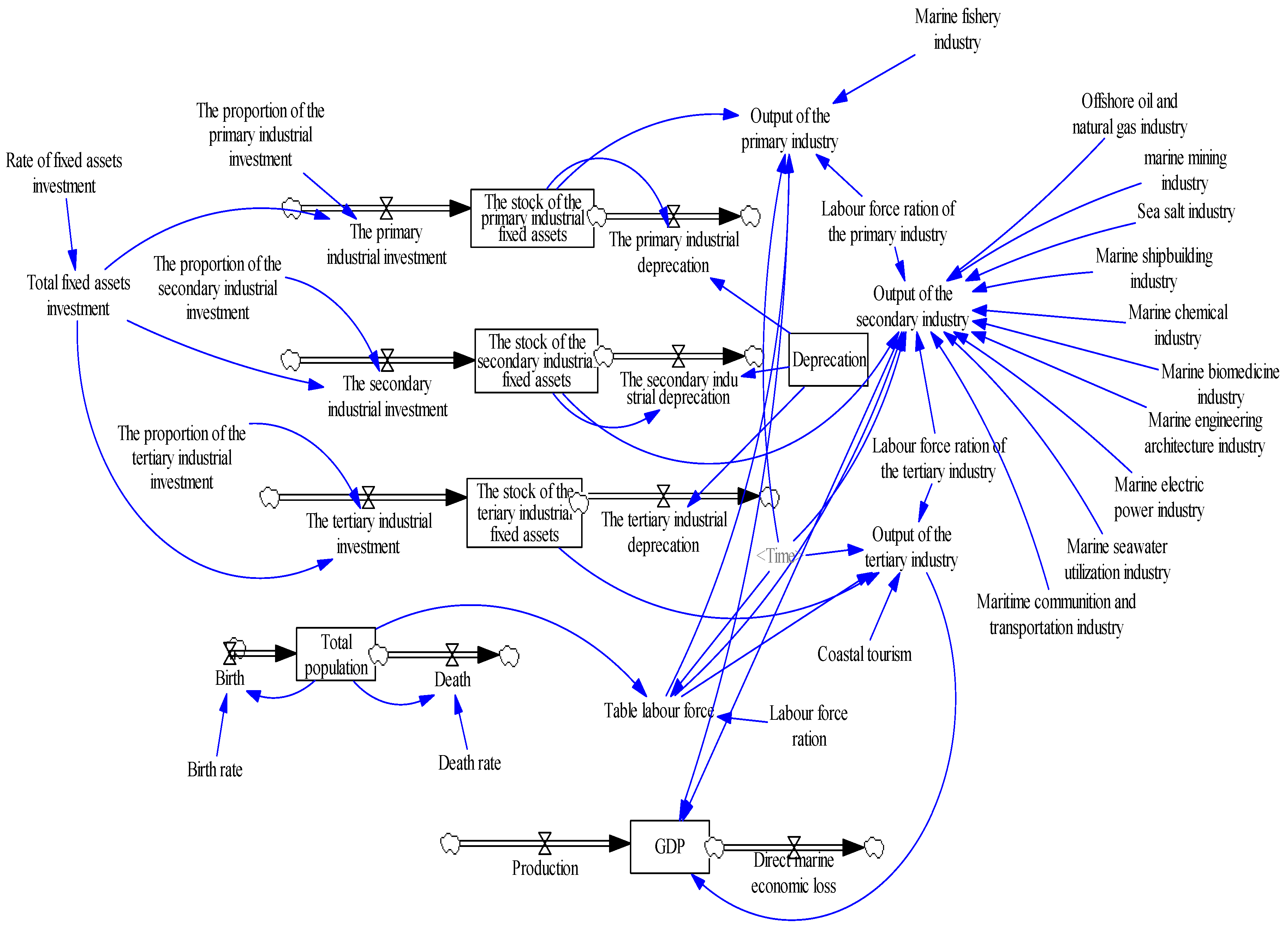
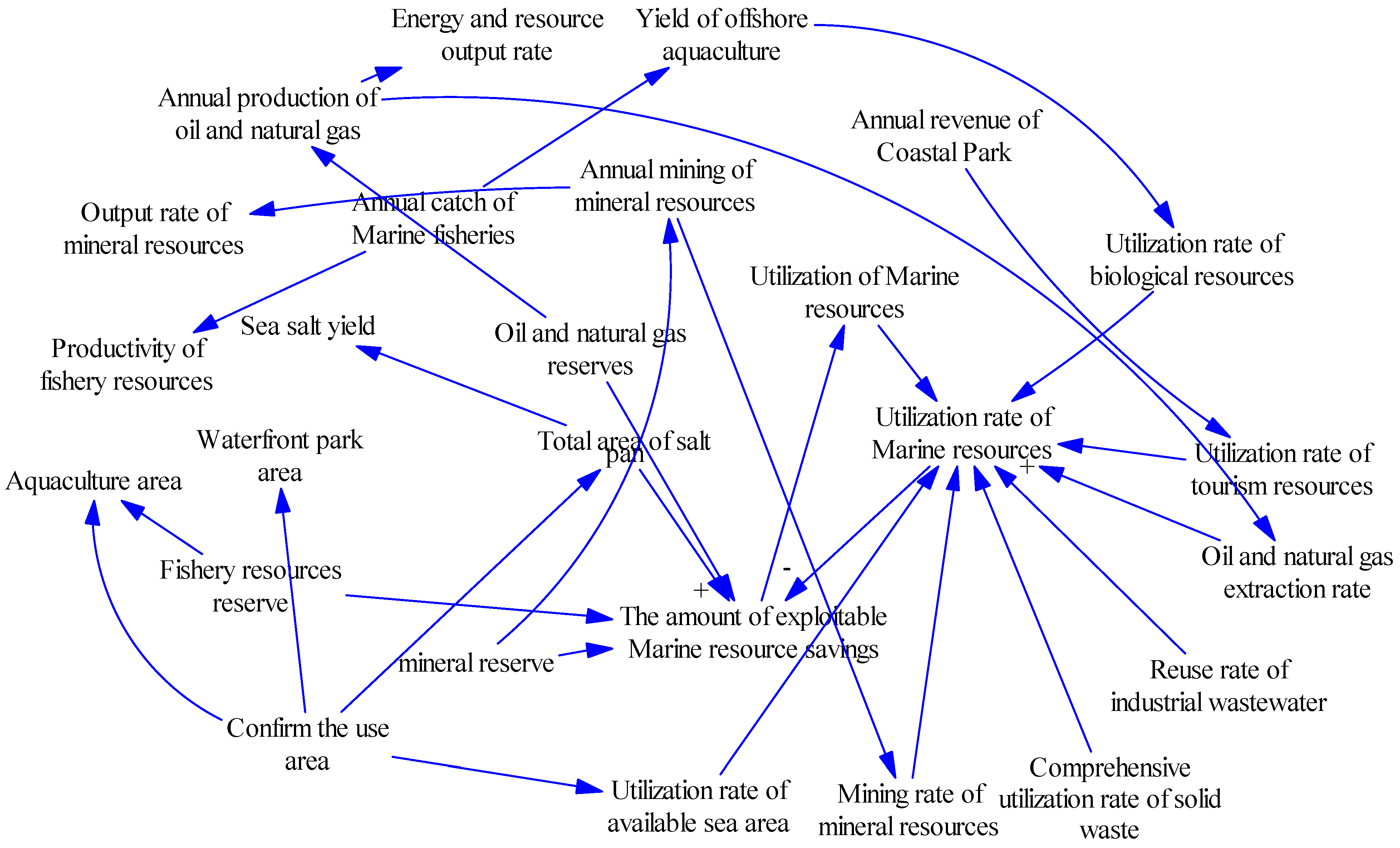
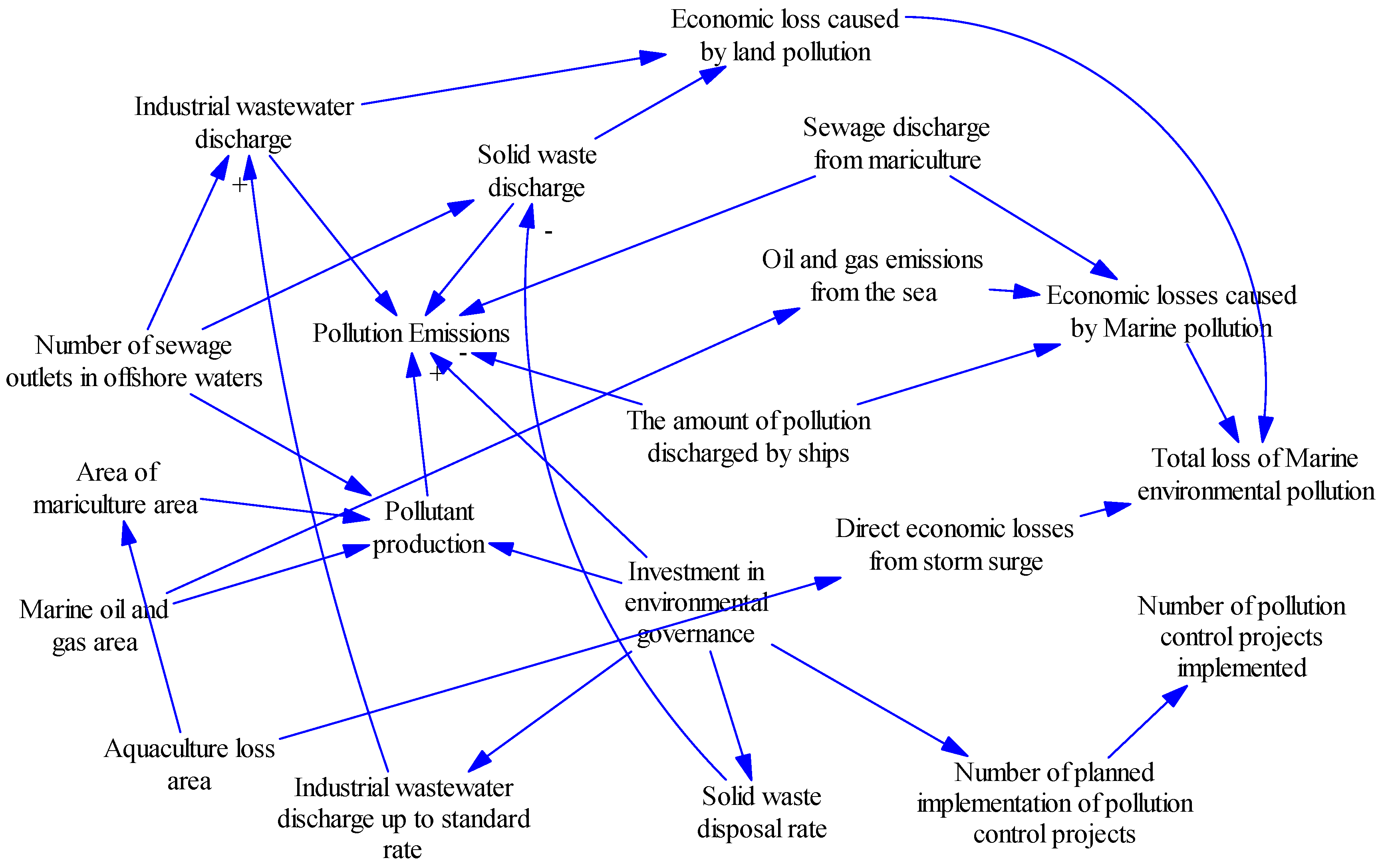
4.3. Model Testing and Scenario Design
4.3.1. Model Run Check
4.3.2. Model History Check
4.3.3. The Set of Different Development Scenarios
4.4. Simulation Result
5. An Evaluation of the Coupling Coordination Degree
5.1. Development of Each Subsystem under Different Scenarios
5.2. CCD Results Under Different Scenarios
- (1)
- Economic scenario: The CCD value grew from 0.28 to 0.32, the lowest among all scenarios. Throughout the simulation interval, the marine economic subsystem performed well, while the marine resources and environment subsystem performed poorly. These findings help clarify the lack of coupling phenomena depicted in Figure 14, demonstrating that an overemphasis on economic development will result in disorganized expansion in China’s maritime economy.
- (2)
- Resource scenario: In this scenario, the CCD value rose from 0.53 to 0.2 before finally reaching the ideal level. This expansion can be separated into two stages (Figure 15). Although the resource level in this scenario peaked between 2023 and 2050, the economic and environmental levels were relatively modest, resulting in a lesser coupling degree than the current and environmental scenarios (Figure 13). As the benefits of enhanced energy structure and natural environment become more obvious after 2023, we see an acceleration in the CCD value during this period.
- (3)
- Environmental scenario: In this scenario, the CCD value rose from 0.37 to 0.46 and remained in the optimal condition. The proportions of each component in this scenario stay high in comparison to other scenarios (Figure 10, Figure 11 and Figure 12). However, as the resource level decreases after 2035, coupling begins to gradually decrease (Figure 11).
6. Conclusions
6.1. Results
6.2. Research Shortcomings
Author Contributions
Funding
Data Availability Statement
Conflicts of Interest
References
- Zeller, D.; Palomares, M.L.; Pauly, D. Global Fisheries Science Documents Human Impacts on Oceans: The Sea Around Us Serves Civil Society in the Twenty-First Century. Annu. Rev. Mar. Sci. 2023, 15, 147–165. [Google Scholar] [CrossRef] [PubMed]
- Chen, J.; Chen, H.; Smith, T.F.; Rangel-Buitrago, N. Analyzing the impact and evolution of ocean & coastal management: 30 years in retrospect. Ocean Coast. Manag. 2023, 242, 106697. [Google Scholar] [CrossRef]
- Desiderius, C.P.M. Coastal and marine resource use conflicts and sustainable development in Tanzania. Ocean Coast. Manag. 2000, 43, 475–494. [Google Scholar]
- Qian, X. Research on the coordinated development model of marine ecological environment protection and economic sustainable development. J. Sea Res. 2023, 193, 102377. [Google Scholar] [CrossRef]
- Wang, S.; Li, W.; Xing, L. A Review on Marine Economics and Management: How to Exploit the Ocean Well. Water 2022, 14, 2626. [Google Scholar] [CrossRef]
- Li, J.-M.; Jiang, S.-S. How can governance strategies be developed for marine ecological environment pollution caused by sea-using enterprises?—A study based on evolutionary game theory. Ocean Coast. Manag. 2023, 232 (Suppl. C), 106447. [Google Scholar] [CrossRef]
- Zhang, K.; Tian, S.-Z.; Wu, Y.; Wu, J.; Liu, N.; Wang, D. Evaluation of China’s maritime power construction index and policy textual analysis. Mar. Econ. Manag. 2023, 6, 59–71. [Google Scholar] [CrossRef]
- Pata, U.K.; Erdogan, S.; Ozkan, O. Is reducing fossil fuel intensity important for environmental management and ensuring ecological efficiency in China? J. Environ. Manag. 2023, 329 (Suppl. C), 117080. [Google Scholar] [CrossRef]
- Yao, W.; Zhang, W.; Li, W. Promoting the development of marine low carbon through the digital economy. J. Innov. Knowl. 2023, 8, 100285. [Google Scholar] [CrossRef]
- Péquin, B.; Cai, Q.; Lee, K.; Greer, C.W. Natural attenuation of oil in marine environments: A review. Mar. Pollut. Bull. 2022, 176, 113464. [Google Scholar] [CrossRef]
- Ren, W.; Ji, J. How do environmental regulation and technological innovation affect the sustainable development of marine economy: New evidence from China’s coastal provinces and cities. Mar. Policy 2021, 128, 104468. [Google Scholar] [CrossRef]
- Kong, H.; Zhang, Y.; Zhang, Y.; Xu, Y.; Zhou, G.; Wang, S. Exploring Integrated Ocean Management Policy in China: Evolution, Challenges, and Prospects. Water 2024, 16, 1673. [Google Scholar] [CrossRef]
- Hu, W.d.; Liu, J.; Ma, Z.; Wang, Y.; Zhang, D.; Yu, W.; Chen, B. China’s marine protected area system: Evolution, challenges, and new prospects. Mar. Policy 2020, 115, 103780. [Google Scholar] [CrossRef]
- Li, Y. Legislation and Policy on Pollution Prevention and the Control of Marine Microplastics. Water 2022, 14, 2790. [Google Scholar] [CrossRef]
- Zou, W.; Yang, Y.; Yang, M.; Zhang, X.; Lai, S.; Chen, H. Analyzing efficiency measurement and influencing factors of China’s marine green economy: Based on a two-stage network DEA model. Front. Mar. Sci. 2023, 10, 1020373. [Google Scholar] [CrossRef]
- Allen, C.; Metternicht, G.; Wiedmann, T. National pathways to the Sustainable Development Goals (SDGs): A comparative review of scenario modelling tools. Environ. Sci. Policy 2016, 66, 199–207. [Google Scholar] [CrossRef]
- Schoenenberger, L.; Schmid, A.; Tanase, R.; Beck, M.; Schwaninger, M. Structural Analysis of System Dynamics Models. Simul. Model. Pract. Theory 2021, 110, 102333. [Google Scholar] [CrossRef]
- Perry, R.I.; Cury, P.; Brander, K.; Jennings, S.; Möllmann, C.; Planque, B. Sensitivity of marine systems to climate and fishing: Concepts, issues and management responses. J. Mar. Syst. 2010, 79, 427–435. [Google Scholar] [CrossRef]
- Wu, Y.; Li, H.; Gu, Y.; Hu, H.; Zhou, G.; Yuan, Q. How can the lead industry improve sustainability based on the resource-economy-carbon nexus system? Sustain. Prod. Consum. 2024, 49, 82–91. [Google Scholar] [CrossRef]
- Zhang, Y.; Zhu, T.; Guo, H.; Yang, X. Analysis of the coupling coordination degree of the Society-Economy-Resource-Environment system in urban areas: Case study of the Jingjinji urban agglomeration, China. Ecol. Indic. 2023, 146 (Suppl. C), 109851. [Google Scholar] [CrossRef]
- Xu, Y.; Chen, B.; Wu, J.; Dan, S.F.; Zhang, X.; Lu, D.; Duan, K. Comparative assessment of the environmental pollution and marine economic growth of Guangxi and China by using the environmental Kuznets curve fitting mode. Environ. Sci. Pollut. Res. Int. 2023, 30, 119406–119418. [Google Scholar] [CrossRef] [PubMed]
- Jin, Y.; Xie, K.; Liu, G.; Peng, Y.; Wan, B. Nonlinear dynamics modeling and analysis of a marine buoy single-point mooring system. Ocean Eng. 2022, 262, 112031. [Google Scholar] [CrossRef]
- Shao, Q.; Guo, G.; Junjie, K.; Kang, P. Environmental response to growth in the marine economy and urbanization: A heterogeneity analysis of 11 Chinese coastal regions using a panel vector autoregressive model. Mar. Policy 2021, 124, 104350. [Google Scholar] [CrossRef]
- Noble, M.M.; Harasti, D.; Pittock, J.; Doran, B. Linking the social to the ecological using GIS methods in marine spatial planning and management to support resilience: A review. Mar. Policy 2019, 108, 103657. [Google Scholar] [CrossRef]
- dos Santos, L.C.T.; Giannetti, B.F.; Agostinho, F.; Liu, G.; Almeida, C.M. A multi-criteria approach to assess interconnections among the environmental, economic, and social dimensions of circular economy. J. Environ. Manag. 2023, 342, 118317. [Google Scholar] [CrossRef]
- Jing, Z.; Wang, J. Sustainable development evaluation of the society–economy–environment in a resource-based city of China:A complex network approach. J. Clean. Prod. 2020, 263, 121510. [Google Scholar] [CrossRef]
- Wang, Y.; Song, C.; Cheng, C.; Wang, H.; Wang, X.; Gao, P. Modelling and evaluating the economy-resource-ecological environment system of a third-polar city using system dynamics and ranked weights-based coupling coordination degree model. Cities 2023, 133, 104151. [Google Scholar] [CrossRef]
- Liu, F.; Huang, Y.; Zhang, L.; Li, G. Marine environmental pollution, aquatic products trade and marine fishery Economy—An empirical analysis based on simultaneous equation model. Ocean Coast. Manag. 2022, 222, 106096. [Google Scholar] [CrossRef]
- Sun, J.; Miao, J.; Mu, H.; Xu, J.; Zhai, N. Sustainable development in marine economy: Assessing carrying capacity of Shandong province in China. Ocean Coast. Manag. 2022, 216, 105981. [Google Scholar] [CrossRef]
- Guo, J.; Yuan, X.; Song, W. Driving forces on the development of China’s marine economy: Efficiency and spatial perspective. Ocean Coast. Manag. 2022, 224, 106192. [Google Scholar] [CrossRef]
- Bao, C.; Wang, H.; Sun, S. Comprehensive simulation of resources and environment carrying capacity for urban agglomeration: A system dynamics approach. Ecol. Indic. 2022, 138, 108874. [Google Scholar] [CrossRef]
- Xing, L.; Xue, M.; Hu, M. Dynamic simulation and assessment of the coupling coordination degree of the economy–resource–environment system: Case of Wuhan City in China. J. Environ. Manag. 2019, 230, 474–487. [Google Scholar] [CrossRef]
- Chen, X.; Yu, Z.; Liang, C.; Di, Q. Where Is the Path to Sustainable Marine Development? Evaluation and Empirical Analysis of the Synergy between Marine Carrying Capacity and Marine Economy High-Quality Development. Water 2024, 16, 394. [Google Scholar] [CrossRef]
- Shao, W.; Xiong, Y.; Shi, D.; Xu, X.; Yue, W.; Soomro, M.A. Time dependent analysis of lateral bearing capacity of reinforced concrete piles combined with corrosion and scour. Ocean Eng. 2023, 282, 115065. [Google Scholar] [CrossRef]
- Yao, W.; Zhang, W.; Li, W.; Li, P. Measurement and Evaluation of Convergence of Japan’s Marine Fisheries and Marine Tourism. Sustainability 2022, 14, 9108. [Google Scholar] [CrossRef]
- Lebdioui, A. The political economy of moving up in global value chains: How Malaysia added value to its natural resources through industrial policy. Rev. Int. Political Econ. 2022, 29, 870–903. [Google Scholar] [CrossRef]
- Wang, S.; Lu, B.; Yin, K. Financial development, productivity, and high-quality development of the marine economy. Mar. Policy 2021, 130, 104553. [Google Scholar] [CrossRef]
- Ababouch, L.; Nguyen, K.A.T.; de Souza, M.C.; Fernandez-Polanco, J. Value chains and market access for aquaculture products. J. World Aquacult. Soc. 2023, 54, 527–553. [Google Scholar] [CrossRef]
- Huyen, N.T.T.; Hoa, T.T.M.; Ha, L.T. The Role of Knowledge-Sharing in Improving Marine Living Resources Towards Sustainable Blue Economy. J. Knowl. Econ. 2024, 195. [Google Scholar] [CrossRef]
- Zhong, H. Exploitation and utilization of marine resources and protection of marine ecology. IOP Conf. Ser. Earth Environ. Sci. 2019, 369, 012009. [Google Scholar] [CrossRef]
- Iyiola, A.O.; Akinrinade, A.J.; Ajayi, F.O. Effects of Water Pollution on Biodiversity Along the Coastal Regions. In Biodiversity in Africa: Potentials, Threats and Conservation; Springer: Singapore, 2022; pp. 345–367. [Google Scholar]
- Kibria, G.; Nugegoda, D.; Rose, G.; Haroon, A.Y. Climate change impacts on pollutants mobilization and interactive effects of climate change and pollutants on toxicity and bioaccumulation of pollutants in estuarine and marine biota and linkage to seafood security. Mar. Pollut. Bull. 2021, 167, 112364. [Google Scholar] [CrossRef] [PubMed]
- Qi, X. The conceptual framework of the national blue economic system: A multiagent perspective. Mar. Policy 2022, 145, 105287. [Google Scholar] [CrossRef]
- Restrepo-Gómez, D.C.; Zetina-Rejón, M.J.; Zepeda-Domínguez, J.A. Trends in marine fisheries social-ecological systems studies. Ocean Coast. Manag. 2022, 220 (Suppl. C), 106076. [Google Scholar] [CrossRef]
- Kedong, Y.; Liu, Z.; Zhang, C.; Huang, S.; Li, J.; Lv, L.; Su, X.; Zhang, R. Analysis and forecast of marine economy development in China. Mar. Econ. Manag. 2022, 5, 1–33. [Google Scholar] [CrossRef]
- Li, L.; Wu, B.; Patwary, A.K. RETRACTED ARTICLE: How marine tourism promote financial development in sustainable economy: New evidences from South Asia and implications to future tourism students. Environ. Sci. Pollut. Res. 2022, 29, 1155–1172. [Google Scholar] [CrossRef]
- Cochrane, K.L. Reconciling sustainability, economic efficiency and equity in marine fisheries: Has there been progress in the last 20 years? Fish Fish. 2021, 22, 298–323. [Google Scholar] [CrossRef]
- Andrews, N.; Bennett, N.J.; Le Billon, P.; Green, S.J.; Cisneros-Montemayor, A.M.; Amongin, S.; Gray, N.J.; Sumaila, U.R. Oil, fisheries and coastal communities: A review of impacts on the environment, livelihoods, space and governance. Energy Res. Soc. Sci. 2021, 75, 102009. [Google Scholar] [CrossRef]
- Xu, Y.; Lin, J.; Yin, B.; Martens, P.; Krafft, T. Marine fishing and climate change: A China’s perspective on fisheries economic development and greenhouse gas emissions. Ocean Coast. Manag. 2023, 245, 106861. [Google Scholar] [CrossRef]
- Bölük, G.; Mert, M. Fossil & renewable energy consumption, GHGs (greenhouse gases) and economic growth: Evidence from a panel of EU (European Union) countries. Energy 2014, 74, 439–446. [Google Scholar] [CrossRef]
- Guo, J.; Jiang, C.; Wang, Y.; Yang, J.; Huang, W.; Gong, Q.; Zhao, Y.; Yang, Z.; Chen, W.; Ren, H. Exploring ecosystem responses to coastal exploitation and identifying their spatial determinants: Re-orienting ecosystem conservation strategies for landscape management. Ecol. Indic. 2022, 138, 108860. [Google Scholar] [CrossRef]
- Ward, D.; Melbourne-Thomas, J.; Pecl, G.T.; Evans, K.; Green, M.; McCormack, P.C.; Novaglio, C.; Trebilco, R.; Bax, N.; Brasier, M.J.; et al. Safeguarding marine life: Conservation of biodiversity and ecosystems. Rev. Fish. Biol. Fish. 2022, 32, 65–100. [Google Scholar] [CrossRef] [PubMed]
- Zhou, Y.; Li, G.; Zhou, S.; Hu, D.; Zhang, S.; Kong, L. Spatio-temporal differences and convergence analysis of green development efficiency of marine economy in China. Ocean Coast. Manag. 2023, 238, 106560. [Google Scholar] [CrossRef]
- Li, Y.; Li, Y.; Zhou, Y.; Shi, Y.; Zhu, X. Investigation of a coupling model of coordination between urbanization and the environment. J. Environ. Manag. 2012, 98, 127–133. [Google Scholar] [CrossRef] [PubMed]
- Cheng, X.; Long, R.; Chen, H.; Li, Q. Coupling coordination degree and spatial dynamic evolution of a regional green competitiveness system—A case study from China. Ecol. Indic. 2019, 104, 489–500. [Google Scholar] [CrossRef]
- Tang, S.; Zhu, Y.; Wang, F.; Shen, N. Can Marketization Improve Sustainable Development in Northeastern China? Evidence from the Perspective of Coupling Coordination Degree Model. Discret. Dyn. Nat. Soc. 2022, 2022, 1–12. [Google Scholar] [CrossRef]
- Chen, X.; Zhou, F.; Hu, D.; Yi, G.; Cao, W. An improved evaluation method to assess the coordination between mineral resource exploitation, economic development, and environmental protection. Ecol. Indic. 2022, 138, 108808. [Google Scholar] [CrossRef]
- Liu, T.-L.; Song, Q.-J.; Lu, J.; Qi, Y. An integrated approach to evaluating the coupling coordination degree between low-carbon development and air quality in Chinese cities. Adv. Clim. Chang. Res. 2021, 12, 710–722. [Google Scholar] [CrossRef]
- Ma, P.; Ye, G.; Peng, X.; Liu, J.; Qi, J.; Jia, S. Development of an index system for evaluation of ecological carrying capacity of marine ecosystems. Ocean Coast. Manag. 2017, 144, 23–30. [Google Scholar] [CrossRef]
- Barlas, Y. Formal aspects of model validity and validation in system dynamics. Syst. Dynam. Rev. 1996, 12, 183–210. [Google Scholar] [CrossRef]

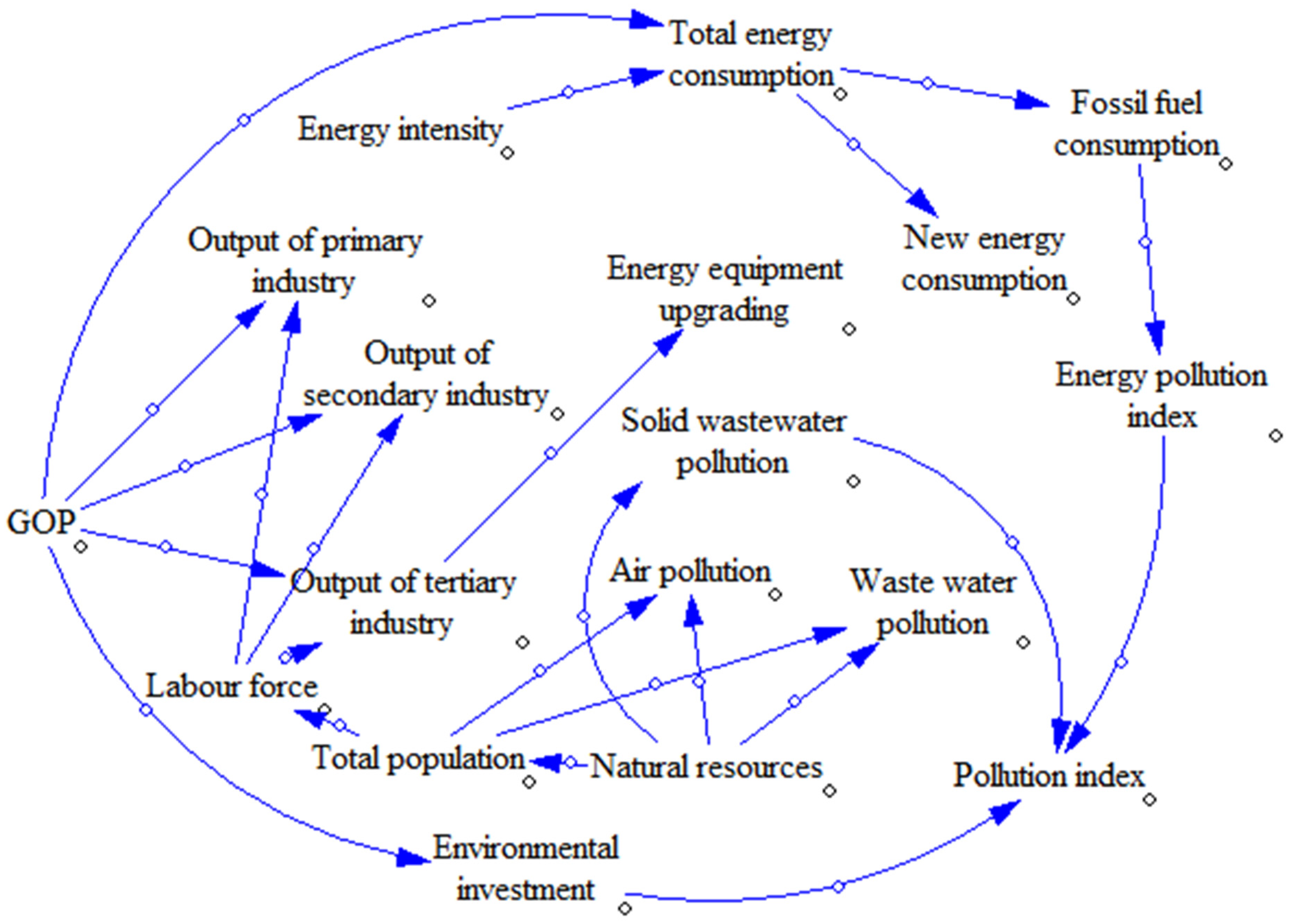




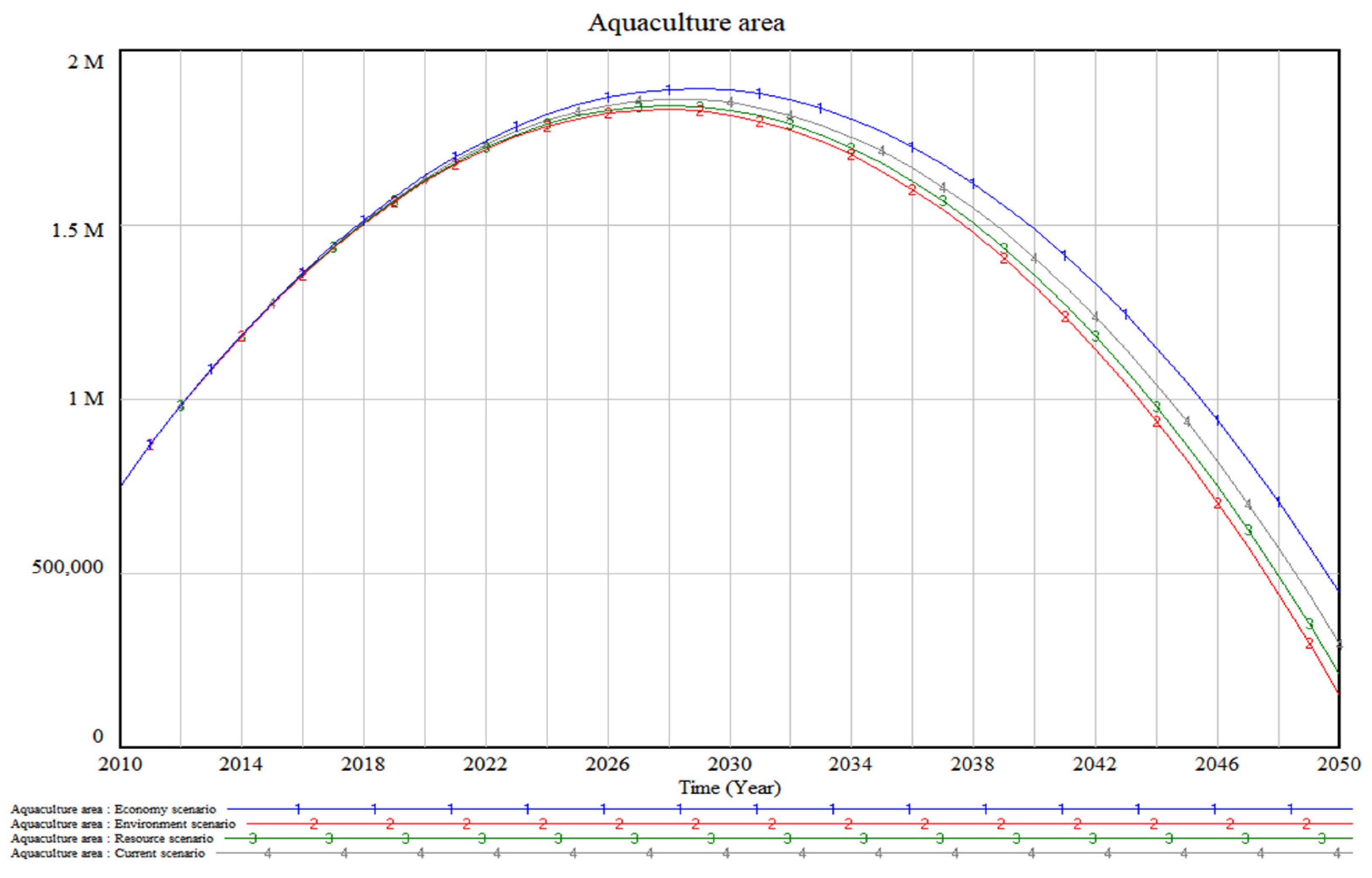
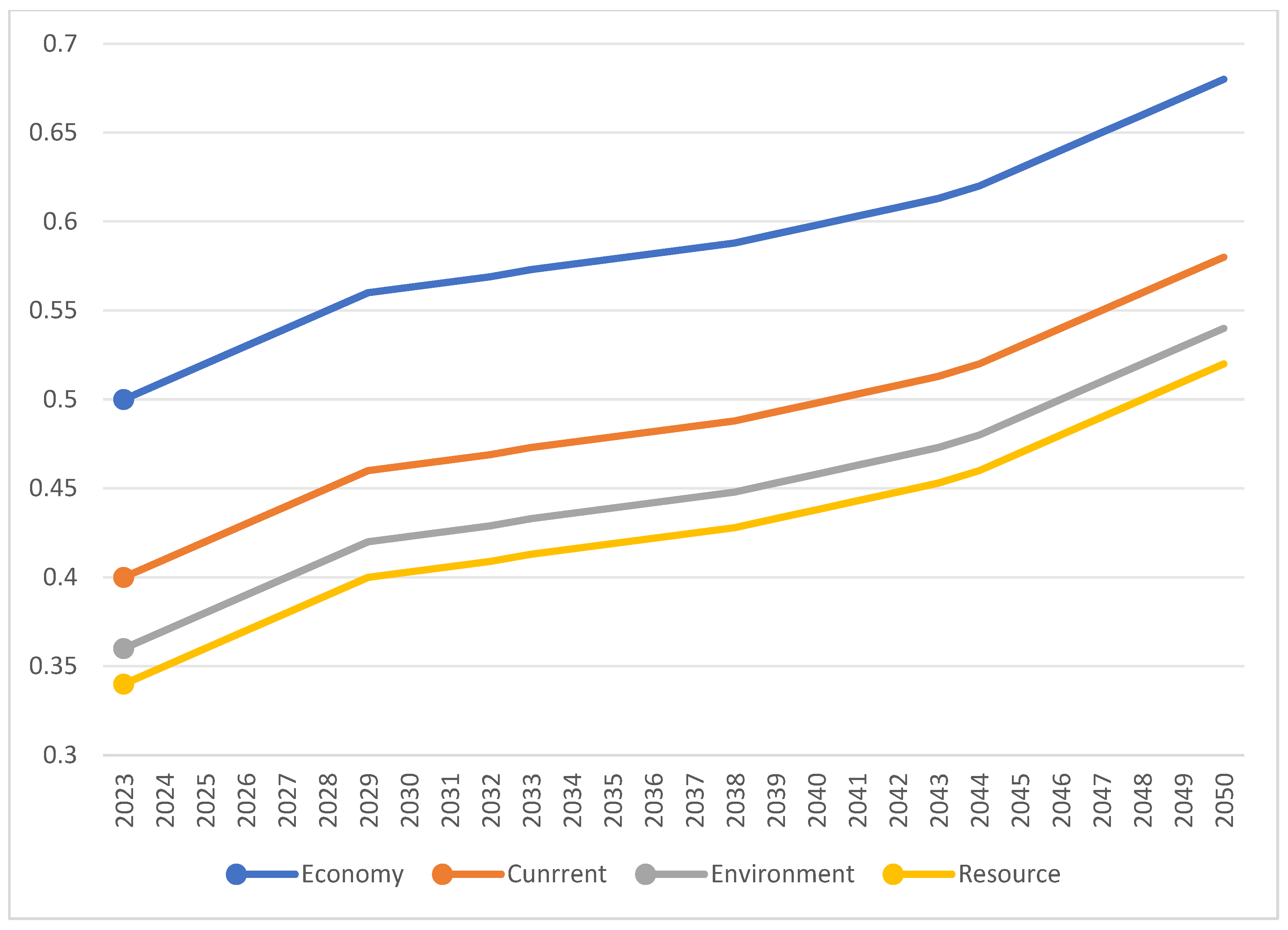

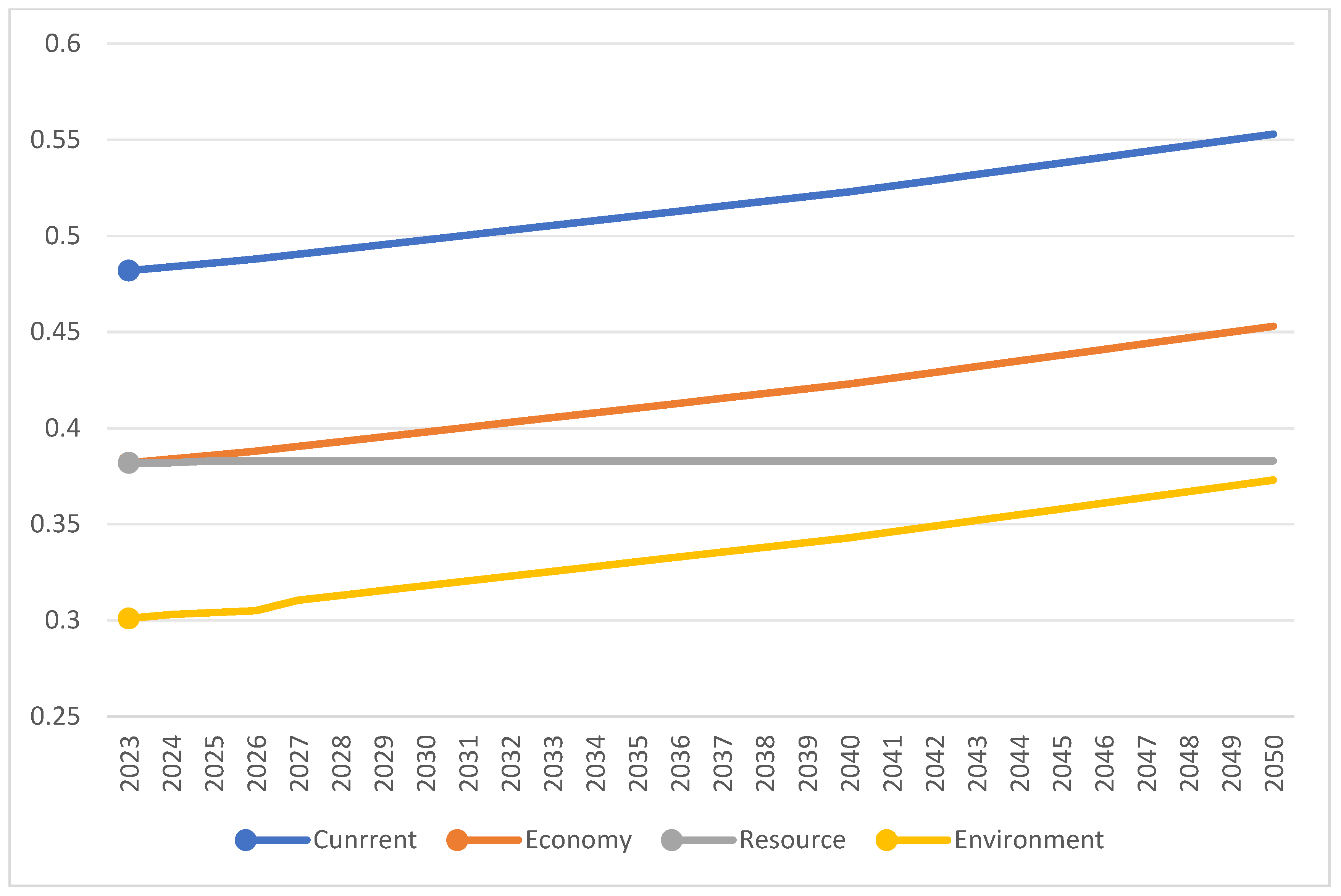
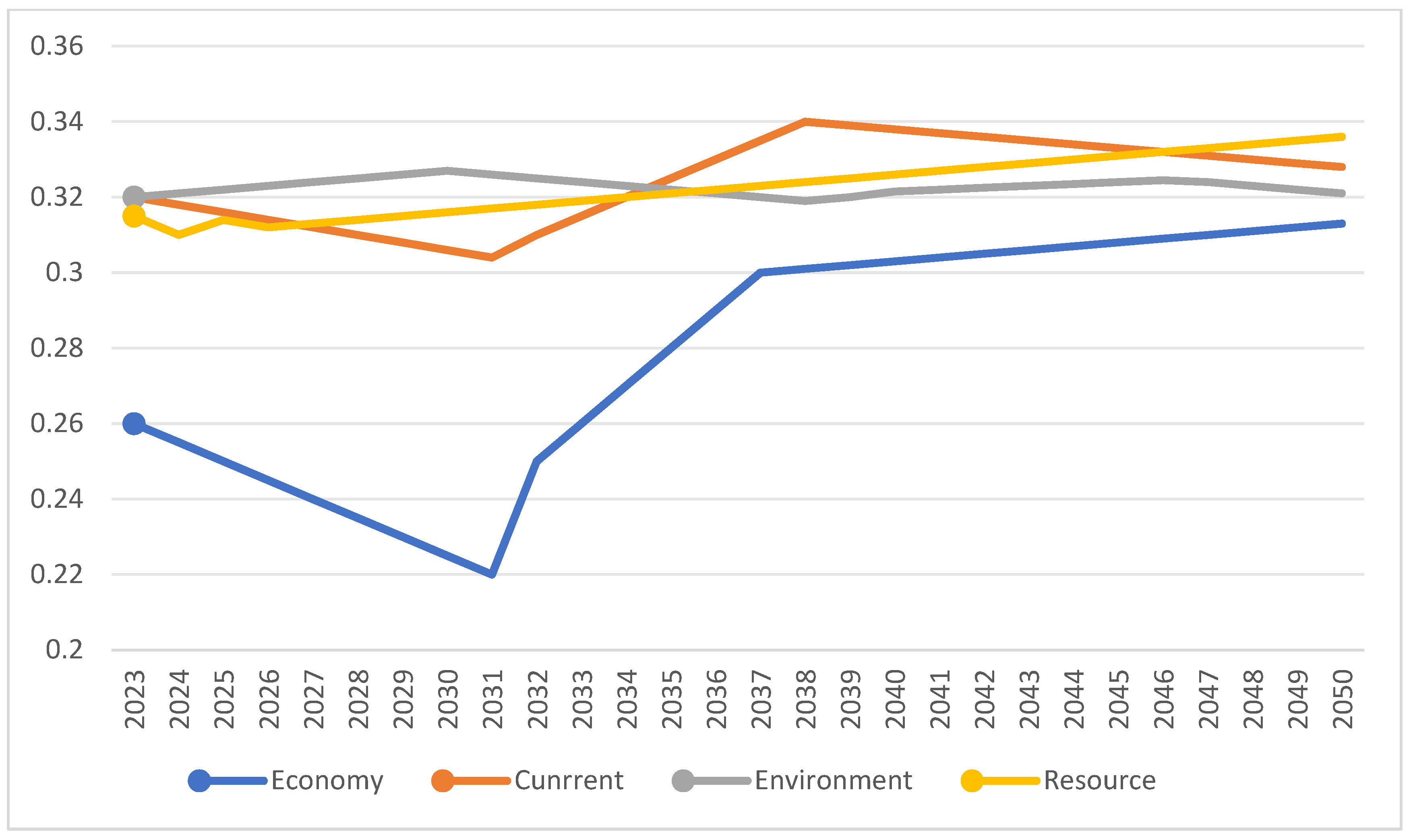

| Value of D | 0≤ D ≤ 0.25 | 0.25 ≤ D ≤ 0.5 | 0.5 ≤ D ≤ 0.75 | 0.75 ≤ D ≤ 1 |
| Development stages | Seriously unbalanced | Slightly unbalanced | Barely balanced | Superior balance |
| Subsystem | Indicator | Direction | Unit | Weight |
|---|---|---|---|---|
| Economy subsystem | Gross ocean product (GOP) | + | Million yuan | 0.2260 |
| Proportion of gross marine product in gross national product | + | % | 0.1354 | |
| Proportion of marine secondary industry | + | % | 0.1390 | |
| Proportion of marine tertiary industry | + | % | 0.1450 | |
| Port cargo throughput | + | Ten thousand tons | 0.0830 | |
| Marine shipbuilding completions | + | Ten thousand boats | 0.1243 | |
| Marine industry employees | + | Thousands of people | 0.0560 | |
| Investment in marine scientific research | + | Million yuan | 0.0913 | |
| Resource subsystem | Sea water breeding area | + | Ten thousand hectares | 0.2430 |
| Confirm area of sea area | + | Ten thousand hectares | 0.1560 | |
| Wetland area | + | Ten thousand hectares | 0.2370 | |
| Marine fishing yield | + | Million tons | 0.1620 | |
| Mariculture yield | + | Million tons | 0.0920 | |
| Sea salt yield | + | Million tons | 0.1100 | |
| Environment subsystem | Direct discharge of industrial wastewater | − | Ten thousand tons | 0.1212 |
| Comprehensive utilization of industrial solid waste | − | Ten thousand tons | 0.2520 | |
| Number of sewage outlets into the sea | − | Quantity | 0.2436 | |
| Marine-type nature reserves in coastal areas | + | Quantity | 0.1350 | |
| Storm surge damage area | − | Ten thousand hectares | 0.2482 |
| Years | GOP | Wastewater Discharge | Aquaculture Area | ||||||
|---|---|---|---|---|---|---|---|---|---|
| True Value | Simulated Value | Relative Error (%) | True Value | Simulated Value | Relative Error (%) | True Value | Simulated Value | Relative Error (%) | |
| 2010 | 39,619.20 | 40,134.25 | 1.30% | 617.00 | 637.98 | 3.40% | 2080.90 | 2135.00 | 2.60% |
| 2011 | 45,580.40 | 47,266.87 | 3.70% | 659.00 | 676.13 | 2.60% | 2106.40 | 2142.21 | 1.70% |
| 2012 | 50,172.90 | 54,387.42 | 8.40% | 685.00 | 695.96 | 1.60% | 2180.90 | 2320.48 | 6.40% |
| 2013 | 54,718.30 | 56,305.13 | 2.90% | 695.00 | 755.47 | 8.70% | 2315.60 | 2380.44 | 2.80% |
| 2014 | 60,699.10 | 61,488.19 | 1.30% | 716.00 | 760.39 | 6.20% | 2305.50 | 2395.41 | 3.90% |
| 2015 | 65,534.40 | 68,483.45 | 4.50% | 735.00 | 766.61 | 4.30% | 2317.80 | 2375.75 | 2.50% |
| 2016 | 69,693.70 | 71,366.35 | 2.40% | 711.00 | 724.51 | 1.90% | 2098.10 | 2232.38 | 6.40% |
| 2017 | 76,749.00 | 77,976.98 | 1.60% | 699.66 | 726.25 | 3.80% | 2084.10 | 2119.53 | 1.70% |
| 2018 | 78,077.80 | 82,528.23 | 5.70% | 682.30 | 718.46 | 5.30% | 2043.10 | 2114.61 | 3.50% |
| 2019 | 84,191.30 | 88,990.20 | 5.70% | 669.00 | 687.06 | 2.70% | 1992.20 | 2049.97 | 2.90% |
| 2020 | 79,549.80 | 82,095.39 | 3.20% | 655.80 | 672.85 | 2.60% | 1995.60 | 2065.45 | 3.50% |
| 2021 | 90,385.00 | 91,469.62 | 1.20% | 633.58 | 666.53 | 5.20% | 2025.50 | 2112.60 | 4.30% |
| 2022 | 89,415.00 | 92,455.11 | 3.40% | 629.36 | 649.50 | 3.20% | 2074.40 | 2132.48 | 2.80% |
Disclaimer/Publisher’s Note: The statements, opinions and data contained in all publications are solely those of the individual author(s) and contributor(s) and not of MDPI and/or the editor(s). MDPI and/or the editor(s) disclaim responsibility for any injury to people or property resulting from any ideas, methods, instructions or products referred to in the content. |
© 2024 by the authors. Licensee MDPI, Basel, Switzerland. This article is an open access article distributed under the terms and conditions of the Creative Commons Attribution (CC BY) license (https://creativecommons.org/licenses/by/4.0/).
Share and Cite
Yao, W.; Wang, X. A Dynamic Simulation and Evaluation of the Coupling Coordination Degree of the Marine Economy–Resource–Environment System in China. Water 2024, 16, 2686. https://doi.org/10.3390/w16182686
Yao W, Wang X. A Dynamic Simulation and Evaluation of the Coupling Coordination Degree of the Marine Economy–Resource–Environment System in China. Water. 2024; 16(18):2686. https://doi.org/10.3390/w16182686
Chicago/Turabian StyleYao, Wei, and Xuefeng Wang. 2024. "A Dynamic Simulation and Evaluation of the Coupling Coordination Degree of the Marine Economy–Resource–Environment System in China" Water 16, no. 18: 2686. https://doi.org/10.3390/w16182686
APA StyleYao, W., & Wang, X. (2024). A Dynamic Simulation and Evaluation of the Coupling Coordination Degree of the Marine Economy–Resource–Environment System in China. Water, 16(18), 2686. https://doi.org/10.3390/w16182686






